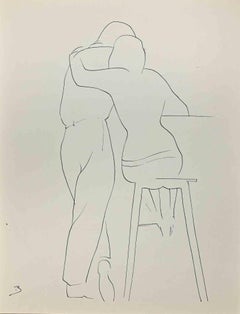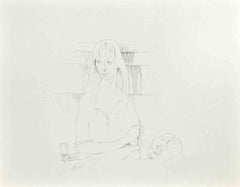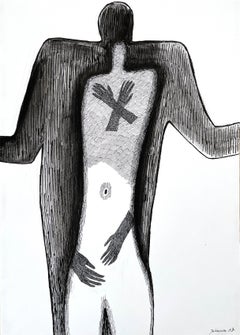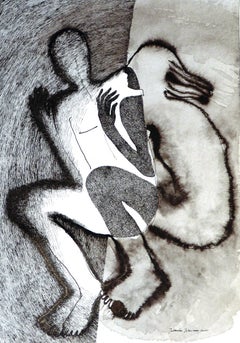Buscot Figurative Drawings and Watercolors
2
to
1
5
4
1
4
1
Overall Height
to
Overall Width
to
3
5
5
4
3
2
1
1
1
5
5
672
326
198
132
3
3
2
1
1
Artist: Buscot
The Couple - Drawing on Paper by Buscot - 1950s
By Buscot
Located in Roma, IT
The couple is an artwork realized by Buscot, 1950s.
Monochrome pen on paper.
30 x 25 cm.
Good condition.
Category
Mid-20th Century Buscot Figurative Drawings and Watercolors
Materials
Pen
Mother and Child - Drawing on Paper by Buscot - 1950s
By Buscot
Located in Roma, IT
Mother and child is an artwork realized by Buscot, dim-20th century.
Pencil drawing, 27 x 21 cm.
Handsigned on the back.
Good conditions, exept for a fold on the lower margin.
Category
Mid-20th Century Modern Buscot Figurative Drawings and Watercolors
Materials
Pen, Paper, Pencil
Portrait of Mother and Child - Drawing on Paper by Buscot - 1950s
By Buscot
Located in Roma, IT
Portrait of Mother and child is an artwork realized by Buscot, in the mid-20th century.
Pencil drawing, 27 x 21 cm.
Handsigned on the back.
Good condition, exept for a fold on t...
Category
Mid-20th Century Buscot Figurative Drawings and Watercolors
Materials
Pencil, Paper
L'Arlequin de Noël - Original Pen Drawing on Paper by Buscot - Mid 1900
By Buscot
Located in Roma, IT
L'Arlequin de Noël is an original artwork realized by Buscot.
Pen on paper. Hand-signed on the lower left corner.
Excellent conditions.
Very fresh drawing realized in pencil by t...
Category
Mid-20th Century Modern Buscot Figurative Drawings and Watercolors
Materials
Pen
Mythological Scene - Original Ink Drawing on Parchment by Buscot
By Buscot
Located in Roma, IT
Mithologic scene is an original artwork by the artist Buscot.
Hand-signed on the lower right. Includes passpartout.
Good conditions except for ink stains on the passpartout.
Category
Mid-20th Century Modern Buscot Figurative Drawings and Watercolors
Materials
Parchment Paper, Ink
Related Items
In Arms Angel
By Jolanta Johnsson
Located in Boxholm, SE
Jolanta Johnsson, experienced Polish artist, graduate of the Academy of Fine Arts in Warsaw, PhD of fine arts, university teacher. She currently lives in Sweden. This is how she writ...
Category
1990s Modern Buscot Figurative Drawings and Watercolors
Materials
Paper, Ink
Timeless Body Art
By Jolanta Johnsson
Located in Boxholm, SE
Timeless Body Art – Jolanta Johnsson, experienced Polish artist, graduate of the Academy of Fine Arts in Warsaw, PhD of fine arts, university teacher. She currently lives in Sweden. ...
Category
Early 2000s Modern Buscot Figurative Drawings and Watercolors
Materials
Ink, Paper
Weltevreden, Kebon Sirih, & Vlucht voor de bui (Fleeing the rain)
Located in Amsterdam, NL
Weltevreden, Kebon Sirih, & Vlucht voor de bui (Fleeing the rain)
Executed between February 20 and March 2, 1918
Double sided drawing in graphite pencil on paper
Images: c. 33 x 5...
Category
1910s Art Nouveau Buscot Figurative Drawings and Watercolors
Materials
Paper, Graphite
Free Shipping
H 19.3 in W 23.63 in D 1.19 in
Study for Sculpture of Nude Woman Balancing Baby
By Chaim Gross
Located in New York, NY
Study for Sculpture of Nude Woman Balancing Baby, 1949, by Chaim Gross (1902-1991)
Ink on paper
10 ½ x 7 ½ inches unframed (26.67 x 19.05 cm)
1...
Category
1940s Modern Buscot Figurative Drawings and Watercolors
Materials
Paper, Ink, Pen
Two Balinese Beauties (Mapeed), circa 1945
By Johan Rudolf Bonnet
Located in Amsterdam, NL
Rudolf Bonnet (1895-1978)
'Mepèèd' (Mapeed)
Signed lower right
Titled upper right
Pastel on gouache pigmented paper, 57 x 34 cm
In original carved ebo...
Category
1940s Buscot Figurative Drawings and Watercolors
Materials
Paper, Crayon, Pastel, Gouache, Pencil
Free Shipping
H 22.45 in W 13.39 in D 0.04 in
Paul Schürch (1886-1939) - Romantic Landscape Drawing 1917 Solothurn Switzerland
Located in Meinisberg, CH
Paul Schürch
(Swiss, ∗ 14.2.1886 Wangen b. Olten, † 11.12.1939 Bern)
Romantic Landscape in area of Solothurn, Switzerland
• Charcoal/Pencil drawing delicately heightened in various...
Category
1910s Naturalistic Buscot Figurative Drawings and Watercolors
Materials
Laid Paper, Pencil, Pastel, Charcoal
Free Shipping
H 11.42 in W 17.92 in D 0.16 in
Village Northern Bali, 1906
Located in Amsterdam, NL
Premises in North Bali, 1906
Signed with initials and titled bottom left and fully signed, bottom right
Pencil and ink on paper, 10.5 x 18 cm
Black ebonized frame with white mount
...
Category
Early 1900s Art Nouveau Buscot Figurative Drawings and Watercolors
Materials
Paper, Graphite
François-Édouard Picot (French 1786-1868) Greek Comedy Play 19th Century Drawing
By François-Édouard Picot
Located in Meinisberg, CH
François-Édouard Picot
(French, 1786 – 1868)
Ancient Greek Comedy Play
• Pencil Drawing on laid paper behind decorative matting, visible image, ca. 10.5 x 15.5 cm
• Modern Glased frame, ca. 27 x 33 cm
• Signed "Picot fecit" lower left
• As we photographed through glass, there are reflections in the images
Worldwide shipping is complimentary - There are no charges for handling & delivery
Here we have the somewhat unusual, yet typical subject matter François-Édouard Picot was interested in depicting. Shown is a scene from an ancient Greek comedy play. The previous owner has noted on the back, that this image was copied from an ancient Greek stone relief.
François-Édouard Picot was born on the 10th of October in 1786 in Paris, France. He studied with various masters and became well known for his historical and mythological subjects. In 1812 he won the second prize in the Prix de Rome competition and after that success, went on to exhibit at the Paris Salon, where in the year 1819 he won a first-class medal for his neoclassical L'Amour et Psyché, which today hangs in the Louvre in Paris. He regularly exhibited his work in the salon up to 1839. He taught several young great artists at his elitist studio and was known for accepting only very few students, which included William Bouguereau, Gustave Moreau, Cabanel and Paul Seignac...
Category
Early 19th Century Naturalistic Buscot Figurative Drawings and Watercolors
Materials
Laid Paper, Pencil
Free Shipping
H 10.63 in W 13 in D 1.19 in
Costume drawings for ‘Ambassadeur de Siam’ and ‘La Sultana Reine’
Located in Amsterdam, NL
Joseph-Marie Vien (1716-1809)
‘Ambassadeur de Siam’ and ‘La Sultana Reine’
Both titled lower centre, the drawing of the ambassador inscribed with colours intended for the prints, e...
Category
Mid-18th Century Old Masters Buscot Figurative Drawings and Watercolors
Materials
Paper, Pencil
Free Shipping
H 9.26 in W 6.89 in D 1.19 in
Au Bord de l'eau, Original Drawing, Pastel, Trees and House along the seafront
Located in AIX-EN-PROVENCE, FR
Work : Original Drawing, Unique Work, Handmade Artwork. The work has been treated with Archival Varnish with UV protection and it is not framed.
Medium : Soft Pastel and Oil based c...
Category
21st Century and Contemporary Impressionist Buscot Figurative Drawings and Watercolors
Materials
Pastel, Archival Paper, Color Pencil
Gabriel RiesnertAu Bord de l'eau, Original Drawing, Pastel, Trees and House along the seafront, 2019
H 6.3 in W 5.91 in D 0.08 in
Jean Cocteau - The Fight - Original Signed Drawing
By Jean Cocteau
Located in Collonge Bellerive, Geneve, CH
Jean Cocteau - The Fight - Original Signed Drawing
1923
28 x 22 cm
Signed
This drawing was made as a frontispiece of the book Dessins publishe...
Category
1920s Modern Buscot Figurative Drawings and Watercolors
Materials
Pen
The Abduction of the Sabine Women , a Renaissance drawing by Biagio Pupini
Located in PARIS, FR
This vigorous drawing has long been attributed to Polidoro da Caravaggio: The Abduction of the Sabine Women is one of the scenes that Polidoro depicted between 1525 and 1527 on the façade of the Milesi Palazzo in Rome. However, the proximity to another drawing inspired by this same façade, kept at the Ecole des Beaux-Arts, and to other drawings inspired by Polidoro kept at the Musée du Louvre, leads us to propose an attribution to Biagio Pupini, a Bolognese artist whose life remains barely known, despite the abundant number of drawings attributed to him.
1. Biagio Pupini, a Bolognese artist in the light of the Roman Renaissance
The early life of Biagio Pupini, an important figure of the first half of the Cinquecento in Bologna - Vasari mentions him several times - is still poorly known. Neither his date of birth (probably around 1490-1495) nor his training are known. He is said to have been a pupil of Francesco Francia (1450 - 1517) and his name appears for the first time in 1511 in a contract with the painter Bagnacavallo (c. 1484 - 1542) for the frescoes of a church in Faenza. He then collaborated with Girolamo da Carpi, at San Michele in Bosco and at the villa of Belriguardo.
He must have gone to Rome for the first time with Bagnacavallo between 1511 and 1519. There he discovered the art of Raphael, with whom he might have worked, and that of Polidoro da Caravaggio. This first visit, and those that followed, were the occasion for an intense study of ancient and modern art, as illustrated by his abundant graphic production.
Polidoro da Caravaggio had a particular influence on the technique adopted by Pupini. Executed on coloured paper, his drawings generally combine pen, brown ink and wash with abundant highlights of white gouache, as in the drawing presented here.
2. The Abduction of the Sabine Women
Our drawing is an adaptation of a fresco painted between 1525 and 1527 by Polidoro da Caravaggio on the façade of the Milesi Palace in Rome. These painted façades were very famous from the moment they were painted and inspired many artists during their stay in Rome. These frescoes are now very deteriorated and difficult to see, as the palace is in a rather narrow street.
The episode of the abduction of the Sabine women (which appears in the centre of the photo above) is a historical theme that goes back to the origins of Rome and is recounted both by Titus Livius (Ab Urbe condita I,13), by Ovid (Fasti III, 199-228) and by Plutarch (II, Romulus 14-19). After killing his twin brother Romus, Romulus populates the city of Rome by opening it up to refugees and brigands and finds himself with an excess of men. Because of their reputation, none of the inhabitants of the neighbouring cities want to give them their daughters in marriage. The Romans then decide to invite their Sabine neighbours to a great feast during which they slaughter the Sabines and kidnap their daughters.
The engraving made by Giovanni Battista Gallestruzzi (1618 - 1677) around 1656-1658 gives us a good understanding of the Polidoro fresco, allowing us to see how Biagio Pupini reworked the scene to extract this dynamic group.
With a remarkable economy of means, Biagio Pupini takes over the left-hand side of the fresco and depicts in a very dense space two main groups, each consisting of a Roman and a Sabine, completed by a group of three soldiers in the background (which seems to differ quite significantly from Polidoro's composition).
The balance of the drawing is based on a very strongly structured composition. The drawing is organised around a median vertical axis, which runs along both the elbow of the kidnapped Sabine on the left and the foot of her captor, and the two main diagonals, reinforced by four secondary diagonals. This diamond-shaped structure creates an extremely dynamic space, in which centripetal movements (the legs of the Sabine on the right, the arm of the soldier on the back at the top right) and centrifugal movements (the arm of the kidnapper on the left and the legs of the Sabine he is carrying away, the arm of the Sabine on the right) oppose each other, giving the drawing the appearance of a whirlpool around a central point of support situated slightly to the left of the navel of the kidnapper on the right.
3. Polidoro da Caravaggio, and the decorations of Roman palaces
Polidoro da Caravaggio was a paradoxical artist who entered Raphael's (1483 - 1520) workshop at a very young age, when he oversaw the Lodges in the Vatican. Most of his Roman work, which was the peak of his career, has disappeared, as he specialised in facade painting, and yet these paintings, which are eminently visible in urban spaces, have influenced generations of artists who copied them abundantly during their visits to Rome.
Polidoro Caldara was born in Caravaggio around 1495-1500 (the birthplace of Michelangelo Merisi, known as Caravaggio, who was born there in 1571), some forty kilometres east of Milan. According to Vasari, he arrived as a mason on the Vatican's construction site and joined Raphael's workshop around 1517 (at the age of eighteen according to Vasari). This integration would have allowed Polidoro to work not only on the frescoes of the Lodges, but also on some of the frescoes of the Chambers, as well as on the flat of Cardinal Bibiena in the Vatican.
After Raphael's death in 1520, Polidoro worked first with Perin del Vaga before joining forces with Maturino of Florence (1490 - 1528), whom he had also known in Raphael's workshop. Together they specialised in the painting of palace façades. They were to produce some forty façades decorated with grisaille paintings imitating antique bas-reliefs.
The Sack of Rome in 1527, during which his friend Maturino was killed, led Polidoro to flee first to Naples (where he had already stayed in 1523), then to Messina. It was while he was preparing his return to the peninsula that he was murdered by one of his assistants, Tonno Calabrese, in 1543.
In his Vite, Vasari celebrated Polidoro as the greatest façade decorator of his time, noting that "there is no flat, palace, garden or villa in Rome that does not contain a work by Polidoro". Polidoro's facade decorations, most of which have disappeared as they were displayed in the open air, constitute the most important lost chapter of Roman art of the Cinquecento. The few surviving drawings of the painter can, however, give an idea of the original appearance of his murals and show that he was an artist of remarkable and highly original genius.
4. The façade of the Milesi Palace
Giovanni Antonio Milesi, who commissioned this palace, located not far from the Tiber, north of Piazza Navona, was a native of the Bergamo area, like Polidoro, with whom he maintained close friendly ties. Executed in the last years before the Sack of Rome, around 1526-1527, the decoration of Palazzo Milesi is considered Polidoro's greatest decorative success.
An engraving by Ernesto Maccari made at the end of the nineteenth century allows us to understand the general balance of this façade, which was still well preserved at the time. The frescoes were not entirely monochrome, but alternated elements in chiaroscuro simulating marble bas-reliefs and those in ochre simulating bronze and gold vases...
Category
16th Century Old Masters Buscot Figurative Drawings and Watercolors
Materials
Ink, Gouache, Pen
Previously Available Items
The Party - Original Ink Drawing on Paper by Buscot
By Buscot
Located in Roma, IT
The Party is an original artwork realized by Buscot.
China ink drawing on paper glued on sheet.
Hand-signed by the artist on the lower right corner.
Excellent conditions.
Category
Mid-20th Century Buscot Figurative Drawings and Watercolors
Materials
Ink
The Party - Original Ink Drawing on Paper by Buscot
By Buscot
Located in Roma, IT
The Party is an original artwork realized by Buscot.
China ink drawing on paper glued on sheet.
Hand-signed by the artist on the lower right corner.
Excellent conditions.
Category
Mid-20th Century Buscot Figurative Drawings and Watercolors
Materials
Ink
The Party - Original Ink Drawing on Paper by Buscot
By Buscot
Located in Roma, IT
The Party is an original artwork realized by Buscot.
China ink drawing on paper glued on sheet.
Hand-signed by the artist on the lower right corner.
Excellent conditions.
Category
Mid-20th Century Buscot Figurative Drawings and Watercolors
Materials
Ink
The Party - Original Ink Drawing on Paper by Buscot
By Buscot
Located in Roma, IT
The Party is an original artwork realized by Buscot.
China ink drawing on paper glued on sheet.
Hand-signed by the artist on the lower right corner.
Excellent conditions.
Category
Mid-20th Century Buscot Figurative Drawings and Watercolors
Materials
Ink
Buscot figurative drawings and watercolors for sale on 1stDibs.
Find a wide variety of authentic Buscot figurative drawings and watercolors available for sale on 1stDibs. You can also browse by medium to find art by Buscot in paper, pen, pencil and more. Much of the original work by this artist or collective was created during the 20th century and is mostly associated with the modern style. Not every interior allows for large Buscot figurative drawings and watercolors, so small editions measuring 5 inches across are available. Customers who are interested in this artist might also find the work of Alexis Mérodack-Jeanneau, Giselle Halff, and Daniel Ginsbourg. Buscot figurative drawings and watercolors prices can differ depending upon medium, time period and other attributes. On 1stDibs, the price for these items starts at $154 and tops out at $610, while the average work can sell for $421.




